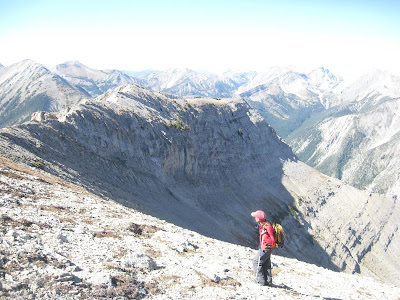 |
| The final ascent |
 |
| Mark Hertenstein walks the extraordinarily scenic ridge line |
 |
| The wind picked us up and slammed us down |
This was a Glacier Mountaineering Society hike I had organized. Eight of us began just west of Swift Reservoir on the North Fork of Birch Creek.
Richmond is a handsome limestone peak that towers above Swift Reservoir west of Dupuyer.
The plan was to pick up the first north ridge off the mountain we encountered and hook to the east and up to the top. I’ve done this before and it is an uncomplicated and straight-forward climb.
However my co-leader Mark Hertenstein thought we might make it more interesting by choosing another, more exposed ridge running off the north flank a couple of miles further up the trail.
The group agreed, and off we went making this an “exploratory” climb.
There are a number of ridges that run down to the North Fork from Mount Richmond, giving us a variety of choice.
Hertenstein thought the fourth one in the line of these ridges to the west might give us the best approach even though it meant hiking past the peak and backtracking to it.
We forded the North Fork and then bushwhacked through heavy forest and deadfall before coming into a lovely gully below a hanging valley at the base of the chosen ridge.
A number of climbers tried working their way up the ridge but couldn’t find a route and did some tedious and treacherous down-climbing.
Hertenstein then suggested side-hilling around the cliffs and climbing to the top on a ramp above the hanging valley. This turned out to be a wonderful suggestion and in short order we were walking on the summit ridge, with an easy ascent to the top.
The views on top were stupendous, enhanced by a bright, clear blue sky, although the predicted winds started to pick up. The Badger-Two Medicine area with Glacier Park peaks dominated the view to the north, the Great Bear and Bob Marshall Wilderness areas to the west, and the Rocky Mountain Front and its high Teton peaks to the south, the Great Plains flowed like an ocean of grass to the east punctuated by the Sweetgrass Hills. I particularly enjoyed the views in the Badger-Two, the peaks of sacred Blackfeet mythology --- Poia, Scarface and Morningstar.
I had expected more fall color than we saw, although the cottonwoods, and ground plants were a brilliant yellow.
At the top we considered the possibility of continuing the climb to the southwest by trying Mount Sentinel.
But, the kniferidge to its summit and increasing winds dissuaded us.
We considered the standard route down the east face, but instead opted for yet another of the ridges into the North Fork, off the smaller of the two Richmond peaks.
We worked our way down through several large cliff bands at the top, descending to broad ridgelines where the wind really began to howl.
At first we got quite a large laugh being blown about.
Then the winds became sustained and the laughing was over. I was thrown to the ground at one point and scratched my glasses and bruised my arms and knee on the sharp limestone rock. Jerry Moore was knocked down trying to help me up and then was knocked over and flat by the wind. He hit his head, but was not seriously hurt. The rest of us were thrown into rocks as we tried to move down the ridge. We could barely move at times and huddled together at points hoping the wind would die down. Paul Cogswell’s sunglasses flew off his face.
Finally, we had no choice but to move off the ridge to the east side that wasn’t getting as badly buffeted.
David Schuler, who retired from a career at sea with the Coast Guard and knows winds when he sees them, estimated the winds at “60 knots,” which he translated as 90 miles an hour.
I’ve been in high winds on the Front before, but I think these were the highest I had ever encountered.
The warm temperatures made them more bearable.
We finally got into the bottoms and enjoyed narrow, scenic small canyons dappled with fall colors before reaching the North Fork.
We all enjoyed the off-trail and unexpected nature of our exploratory, but it will be the wind that we’ll remember the most.










